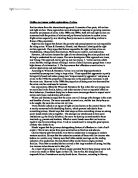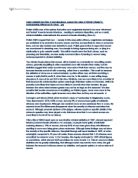Evidence shows that men are much more likely to commit crime than women. In 2002 over 80% if crimes committed were by men (Home office, 2003). This shows that most crimes are committed by men.
The Chicago school research by Shaw and McKay (1942) shows that most crimes were committed by people from Zone 1 location e.g. 9.1% of males from Zone 1 were charged with criminal offences. Zone 1 was where new comers began their urban life and this was a zone of transition (A zone with shifting population of people coming in and people going out). People who were poor & in search of cheap accommodation settled in Zone 1. This shows that most crimes are committed by urban males in poor areas.
Firstly Subcultural theory by Albert Cohen (1955), states that as there is great importance given to success (money and material possessions), those people that cannot achieve the normal means of getting to success experience status frustration. These young males then turn to crime and form their own subculture (their own norms and values which differ from those of mainstream society and are able to obtain status in the eyes of their peers. This shows that these young males turn to crime to get back at society which denies them the normal means of getting to success.
Labelling theory argues that young urban males are labelled as deviant from society, which may lead to rejection from social groups. Becker states that deviance is a process whereby the labelling of the deviant actor as such gradually becomes a self-fulfilling prophecy-’the deviant identification becomes the controlling one’. They accept their deviant identity and join organised deviant groups which leads to the formation of a deviant subculture which support their deviant behaviour. This shows the young urban males are labelled as deviant by society which affects their identity and status and leads to further deviant acts.
There are many disadvantages to this view. labelling theory fails to explain why some people are selected as likely deviants rather than others. Also people do not just become criminals become they are labelled as such. They know that they are breaking the law e.g. people don’t just become burglars just become they are labelled as such.
Control theory states that young people have less to lose than others as they do not have any effective bonds. Hirsch (1969) argues that those people who do have effective bonds do not want to risk losing good opinions of significant others so do not turn to crime. As the gap between childhood and adulthood has widened during and the traditional bonds created by work and marriage were not established until later in life so young people get involved in crime and deviate from social bonds. This shows the young urban males commit crime due to the weak social bonds with people and the widened gap between childhood and adulthood. The disadvantage of control theory is mainly that it fails to explain why some young urban males express their freedom in crime rather than other activities.
Young working class men express their masculinity to themselves and others by turning to crime (James Messerschmidt, 1993). Young men want to accomplish hegemonic masculinity (The dominant and ideal form of masculinity that most men seek to accomplish) so young men are more likely to resist school and construct their masculinity around anti social behaviour and delinquency. This shows that young urban males turn to crime to express their masculinity.
Although the criticism for this view is firstly that the claim that all men want to accomplish hegemonic masculinity is questionable as this can be more of a popular stereotype. Secondly Messerschmidt uses the idea of masculinity to explain all crime that men commit e.g. rape theft, domestic violence. Collier (1998) argues that Messerschmidt stretches the concept of masculinity much to far.
To conclude all these theories have certainly made an important contribution to the understanding of why mostly young urban males commit crime. Information from Home office, and social trends survey provide us with evidence that young urban males do commit high rates of crime but how accurate and reliable these figures are is questionable. The Chicago school research shows that most crimes are committed by those from zone 1 (Zone of transition), while labelling theory argues that deviance by young urban males is a result of individuals being labelled by society. Also Messerschmitt argues that these young men are turning to crime to express their masculinity but are all crime committed by men to express their masculinity (e.g. rape). This shows that there is no absolute truth. I think that most people commit crime so they can get back at society which denies them the normal means of getting success








